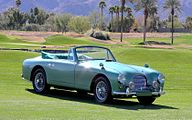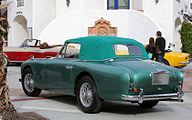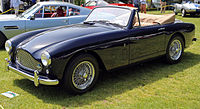Aston Martin DB2 / 4
| Aston Martin DB2 / 4 | |
|---|---|
| Production period: | 1953-1959 |
| Class : | Sports car |
| Body versions : | Station wagon , convertible , roadster |
| Previous model: | Aston Martin DB2 |
| Successor: | Aston Martin DB4 |
The Aston Martin DB2 / 4 is a sports car from the automobile manufacturer Aston Martin . The construction of the model offered from 1953 to 1959 was based on the DB2 , which it replaced. However, it was designed as a 2 + 2-seater and thus had two emergency seats in the rear. The car was one of the first vehicles to have a new type of tailgate. Other changes included a panoramic windshield, larger bumpers and offset headlights. As with the previous model, there was also a convertible , and few Spider built by Bertone .
Mark I.
| Mark I. | |
|---|---|
|
Aston Martin DB2 / 4 Mark I (1953–1955) |
|
| Production period: | 1953-1955 |
| Body versions : | Station wagon , convertible , roadster |
| Engines: |
Petrol engines : 2.5-3.0 liters (92-103 kW) |
| Length: | 4300 mm |
| Width: | 1650 mm |
| Height: | 1360 mm |
| Wheelbase : | 2511 mm |
| Empty weight : | 1179 kg |
The Mark I was equipped with the Lagonda six-cylinder twin-camshaft engine designed by Walter Owen Bentley , which was also used in the Vantage version of the DB2. The displacement of the VB6E engine was 2580 cm³, the output 125 bhp (92 kW). From mid-1954, the VB6 / J engine with 2922 cm³ and 140 bhp (103 kW) was installed, which accelerated the car up to 192 km / h.
102 of the 565 Mark I models were designed as convertibles. One appeared in the Alfred Hitchcock film The Birds .
Three factory cars were made available for the 1955 Monte Carlo Rally and two for the Mille Miglia , but the company focused more on the DB3 racing car model .
Mark II
| Mark II | |
|---|---|
|
Aston Martin DB2 / 4 Mark II (1955–1957) |
|
| Production period: | 1955-1957 |
| Body versions : | Station wagon , convertible , roadster |
| Engines: |
Otto engine : 3.0 liters (103–121 kW) |
| Length: | |
| Width: | 1650 mm |
| Height: | 1360 mm |
| Wheelbase : | |
| Empty weight : | |
The Mark II model introduced in 1955 had the option of a larger valve engine developing 165 bhp (121 kW). Other changes included small tail fins , bubble-shaped taillights like the Hillman Minx and additional chrome trim. A two-seat coupe was also new on the market; the convertible continued to be built. Of a total of 199 Mark II models, only 30 were built as coupes.
Three Mark II chassis were sent to Carrozzeria Touring in Italy to develop Spider models. Touring later helped Aston Martin with the "Superleggera" in the construction of the DB4 .
A key change behind the scenes with the launch of the Mark II was the transfer of body responsibility from the Feltham plant to the Tickford Coachbuilding Works in Newport Pagnell . David Brown bought these factories in 1954 and relocated all manufacturing there when production of the DB4 began .
Mark III
| Mark III | |
|---|---|
|
Aston Martin DB2 / 4 Mark III (1957-1959) |
|
| Production period: | 1957-1959 |
| Body versions : | Kombicoupé , convertible |
| Engines: |
Otto engine : 3.0 liters (121–143 kW) |
| Length: | 4356 mm |
| Width: | 1651 mm |
| Height: | 1360 mm |
| Wheelbase : | 2515 mm |
| Empty weight : | 1270 kg |
In 1957 the model DB2 / 4 Mark III - often just called DB Mark III or Mark III - was introduced. It had the further developed 2.9-liter engine of the Mark II. Other changes concerned the radiator grille, which now looked similar to that of the DB3 / S , a new dashboard and the option of having Girling disc brakes installed. The hydraulic clutch was also new, an overdrive from Laycock-de-Normanville on request or - also on request - an automatic transmission. The steering and drive axle construction were carried over from the previous model. The tail fins were also modified so that the Humber Hawk's taillights could be used.
A double exhaust was optionally available for the standard DBA engine taken over from the Mark II , which increased the engine output to 178 bhp (131 kW). Equipped in this way, the car reached 100 km / h in 9.4 s and drove 192 km / h. An optionally available high-performance machine , type DBB , with three Weber carburetors, sharper camshafts and double exhaust reached 195 bhp (143 kW), but is rarer than the DBD machine in the medium output range of 180 bhp (132 kW).
Girling disc brakes received all Mark III from the 101st copy as basic equipment. Many cars previously made have been retrofitted.
Out of a total of 551 units, only five were built with an automatic transmission.
A report in Road & Track magazine in 1959 praised the car but criticized its high price of US $ 7,450 . “The Aston Martin has many advantages and few defects.” The latter included stiff steering, high sills and poor maneuverability. The new station wagon design with tailgate and folding rear seats, which had already been introduced in the Mark I in 1953, was not mentioned.
As with the previous model, coupé and convertible versions were again offered. Five coupés with DBB engines and 84 convertibles were produced. Both variants had no tailgate, but a conventional trunk lid.
In the novel Goldfinger , James Bond drives an Aston Martin DB 2/4 Mark III. However, this is incorrectly referred to as DB III . It is the only car in the James Bond novels that is specially equipped. In the film , which came out half a decade later, an Aston Martin DB5 was used because it was the current model at the time of shooting.
production
- Mark I: 565 pieces
- including convertibles: 102 pieces
- of which Bertone Spider: 4 or 5 pieces
- Mark II: 199 pieces
- including coupés: 34 pieces
- including cabriolets: approx. 16 pieces
- of which Touring Spider: 3 pieces
- Mark III: 551 pieces
- including convertibles: 84 pieces
- of which with DBA engine: 68 pieces
- of which with DBB engine: 2 pieces
- of which with DBD motor: 14 pieces
- Coupés: 5 pieces
- including convertibles: 84 pieces
Web links
- DB2 / 4 saloon on astonmartins.com (English)
- Aston Martin DB Mark III on astonmartins.com (English)
Individual evidence
- ↑ Steve Wakefield / Mathias Paulokat: Aston Martin DB2 / 4 Drophead Coupé: Beware of the birds! classicdriver.com, April 29, 2013, accessed June 17, 2013 .









